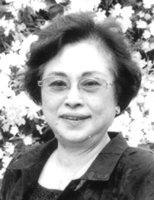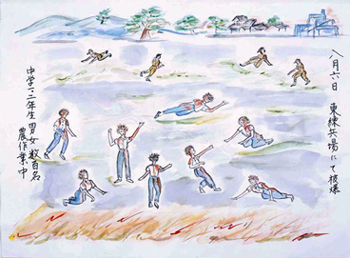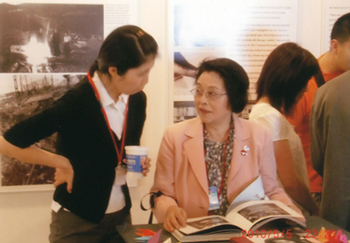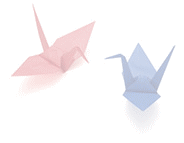Memoir of the A-bombing:
Sharp Flash: The Unforgettable Day |
 |
by Setsuko Morita
Atomic Bomb Witness for This Foundation |
|
|
It was four months before the end of the war that I was able to start at
the girl's school that I had always wanted to go to. Because of wartime
shortages, I could not get all of my uniform. So I just had black dress
material with two white stripes, a white tie and a school badge in the
shape of a plum blossom. There were only two classes in my school year.
The school was Daini-kenjo: Second Prefectural Girl's High School, which
was near my home. At my school, I sewed a blouse for the first time. Since
white sailor-type uniforms were forbidden at that time, that blouse was
for my summer uniform and was not pure white. All female students had to
wear "monpe"(*1) during the mobilization(*2).
On August 6, the location of labor service was assigned for each school,
and we were divided into two groups: the building demolition(*3) group and the agricultural work group. The West class of second-year students
headed to the place known at the time as Zakoba-machi (close to Hiroshima
City Hall), and the remaining three classes of first- and second-year students
made their way to the field at the East Drill Ground near the north exit
of Hiroshima Station.
I was completely exhausted from the daily heavy physical work, but I
started weeding about 8am. It was ten minutes later that it happened. There
was a sudden sharp flash. I was overcome by the blast and my body was thrown
into the air. |
It seems that I passed out for a few minutes. The next thing I knew, the area around me was dark, and I was surprised by figures looking like ghosts that stood up one after another in the midst of the smoke. Everyone had burnt hair and their clothes were hanging down in rags. They were shaking and could not say a word. It was like a nightmare, and I started to wonder what I looked like.
Both my arms were burned. The skin of the inner side of my left arm was
hanging down to my fingertips, and the skin of my elbow on the outer side
of my right arm was torn. From the wrist and beyond were all blisters.
The back of my right leg was all burned. I supposed I had my back turned
when the bomb dropped. |

| East Drill Ground ("A-bomb Drawings by Survivors", Mrs. Setsuko
Morita) |
|
Our young school mistress was also seriously injured. Nevertheless, a
few of us gathered together at a time and evacuated to Hiroshima Tosyogu,
a shrine nearby. We splashed water from our drink bottles on each other
to relieve the pain while we waited for aid, but no one came. The city
was engulfed in black smoke and flames. A bunch of people looking unearthly
distressed were coming my way, crying out strangely.
Those of us who were able to walk were divided into several groups, and
headed for our school, which was located in Ujina at the time. We could
not enter the city center, so we headed south, walking along the military
railway tracks from Hiroshima station. On the way, when we crossed the
bridge over Enko-gawa River, it looked like someone tripped and fell into
the river. Looking down, I saw many corpses floating down the river from
upstream.
The school was still standing, but the building was damaged and we could
not go inside, so we went to ask for help at the girls' vocational school
that was just next door. The classrooms, corridors and Mushiros(*4) spread out in the exercise yard were full of seriously injured people.
On the afternoon of the following day, a relief car came to help.
My home near the school was half-destroyed but still standing, and my
father and mother were alive with light injuries. They desperately tended
my wounds that smelled like something rotting, and I made a fair recovery
in about three months. |

Ms. Morita (second from left) involved in testimony activities at the A-Bomb
Exhibition at United Nations Headquarters in May last year. |
Of the West class of second-year students who were involved in building
demolition work at Zakoba-machi, 38 students died. They say that the only
one to survive, Ms. Setsuko Sakamoto, is the model for the film "Children
of Hiroshima" (directed by Kaneto Shindo, released in 1952).
First-year students who survived with keloid scars on their faces apparently
hid themselves from view during their puberty and youth. I felt lonesome
through the first half of my life with no children, but now I am encouraged
by meeting children through my A-bomb testimony activities. |
| (*1) |
Loose-fitting work trousers for women that are tapered at the ankle. |
| (*2) |
Students were forcefully mobilized to work at factories and the like to make up for labor shortages. |
| (*3) |
To prevent fires caused by air-raids from spreading to surrounding areas, buildings were torn down in advance, to create a fireproof area. |
| (*4) |
Mats made of straw or other grass material. |
|
|
[profile]
Setsuko Morita
Born November 22, 1932. Experienced the atomic bombing at East Drill Ground,
approximately two kilometers from the hypocenter, at the age of twelve
as a first-year student at Second Prefectural Girl’s High School. From
the age of 56, started activities as an atomic bomb witness, at a group
to pass on stories of the A-bombing, an association of A-Bomb sufferers
in Hiroshima Prefecture, and others. Registered last year as an Atomic
Bomb Witness for This Foundation. Also participates in peace activities
overseas, and gave an atomic bomb testimony in New York in May of last
year and in Paris in February this year. |
|
|
|




